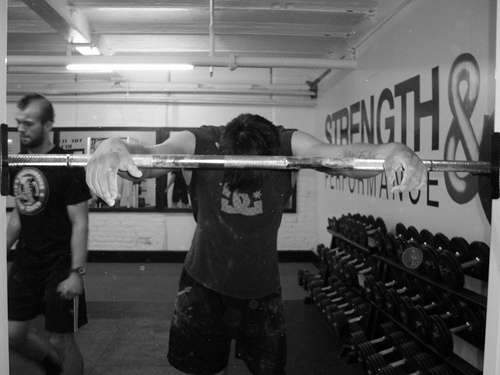
If you’re a consistent reader of this blog you’ll know that I’m big into building a body that is well-rounded both from a health, aesthetic, and performance standpoint. This also means a body that has few weaknesses, which brings me to Joe.
Joe approached me with a few guest article ideas for the site, and the one you’re about to read stuck out. We all have weaknesses in life and training that we hesitate to work on. Here’s an article about how to improve those weaknesses and even make them our strengths.
———–
You know the scenario. You see the same person in the gym doing the same exercises over and over again. They get pretty competent at those exercises, but if you ask them to step out of their comfort zone they don’t like it.
We all have weaknesses. If you think you don’t, you’re kidding yourself and you’re holding your development back.
Doing things we suck at it is hard. It hurts our pride, our ego and our confidence. But if you can handle these feelings and work on what you truly need to improve, then real progress can be made. You can turn your weaknesses into your strengths.
What you can do
Address your weaknesses by doing a full session comprised of nothing but the exercises you are weakest on.
Step one – make a list of your weakest exercises. If you don’t know which ones to pick then here’s a clue; it’s probably the exercises you hate.
Here’s my list:
Front squats
Weak triceps
Bulgarian split squats
Turkish get ups
Side planks
Overhead pressing
Glute ham raises
Step two – as well as the lifting side of training, make a list of all the mobility deficits you have or the mobility exercises you dislike. Here’s mine:
Soft tissue quality of the back of my shoulder
Glute activation, particularly single leg hip thrusts
Pec stretching
Hip mobility
Step three – next using those exercises put them into a session plan. Feel free to choose any order or rep scheme but here’s a template I’ve used with the exercises from my “Weak” list.
Here’s an example session:
Warm up – include soft tissue work, goblet squats, pec stretching and hip thrusts
A1: Bulgarian split squats – 4×6 reps (each side)
A2: Single Leg hip thrusts – 8 reps
A3: Hip flexor stretching – 20 seconds
B1: DB single arm shoulder press 3×8 reps
B2: Glute ham raises – 3×10 reps
C1: Turkish Get ups – 3×3 reps (each side)
C2: Side plank – 3×30 seconds (each side)
Doesn’t look much on paper, but this session will kick my ass.
Other things to consider
Do you talk too much when you train, and take too long between sets? Well for this session try upping the tempo and saving the chat till later.
Do you normally train with someone? I like training in a group. I thrive on the competition and support, which comes along with it. I hate training on my own. But I force myself to do it sometimes. There won’t always be someone there to motivate you and you have to find the internal motivation and desire to train hard on your own.
Now what?
A workout of weaknesses can be a great change of pace every once in a while. You might want to use it more regularly though, if you think your weaknesses need a lot of work. One way to structure your training programme is to do a plan which involves three sessions a week. I’d split these into an upper body session, a lower body session and then a full body session, which is based solely on your weak points.
What to expect
You will probably hate this session to start with. But stick it out and you will see the results. For example, I used to be terrible at overhead pressing. At 6’5”, I thought that my long arms were the reason I was so bad at it. I told myself I didn’t need to do it, and just using horizontal pressing would be fine.
Wrong.
I started overhead pressing. It sucked and my starting weight was embarrassing. But after a few months I had added 35lbs to my one rep max. Granted, it’s still is one of my weakest lifts, but it has become one of my favourites. And guess what? My shoulders, arms and traps got bigger, I’m a better athlete, and my other lifts have benefited too.
Don’t think that this just applies to the gym. Everyone had weaknesses in life. Using the same principles from the gym can benefit you outside of it too. Take a day where you do nothing but address your other weaknesses.
- Hate reading or networking? Spend a day with a book you should have read and then go meet some people.
- How about if you suck at sticking to your nutrition plan? Make some time to go food shopping and cook up some big batches of food for the week.
The bottom line
Addressing weaknesses is hard, but if done properly the benefits are huge. Don’t be one of those people who ignores their weaknesses, stays in their comfort zone and never progresses.
————————————————————————————————–
